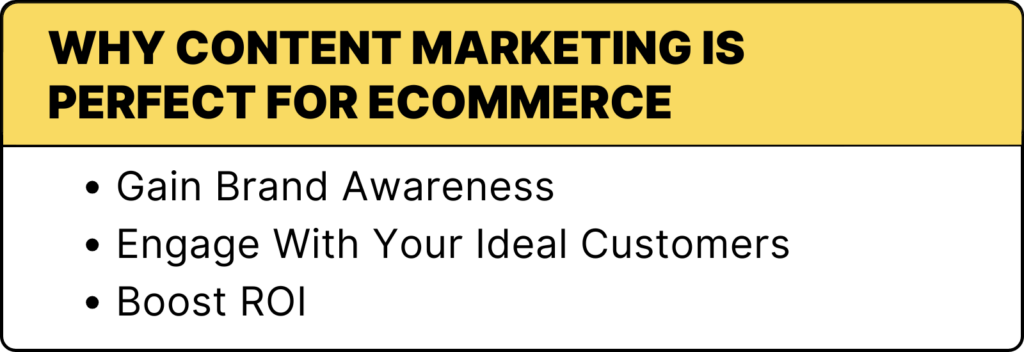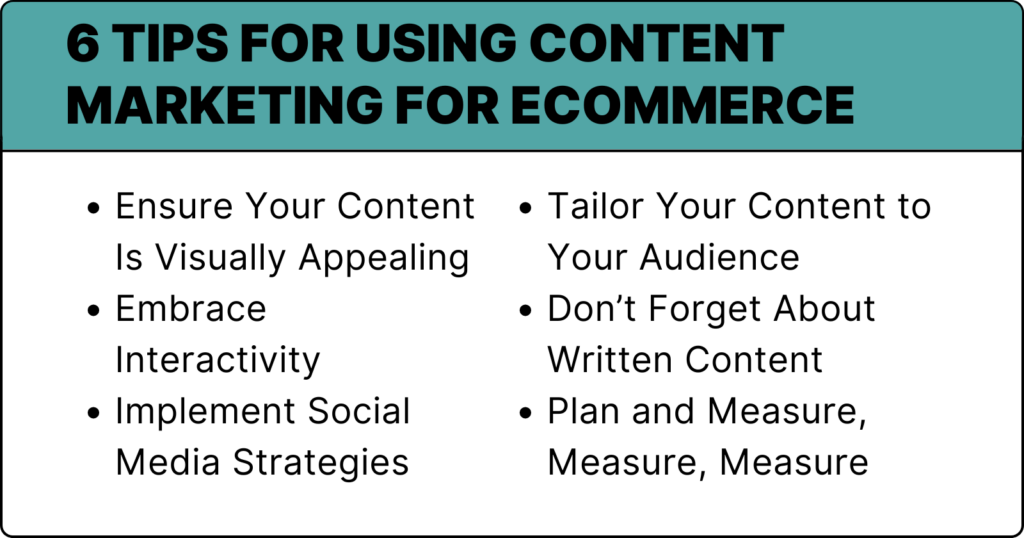The holidays are just around the corner, and EMARKETER predicts that ecommerce will drive at least $1 out of every $5 spent this holiday season. Cyber Monday is the biggest shopping day of the year for online businesses, and you’ve likely already planned big promotions and increased your ad spend to drive traffic to your website.
But there’s another way to drive awareness of your organization and increase your return on investment (ROI), without significant spending. And best of all, it works any time of year — not just before the holiday shopping rush. A strong content marketing strategy can introduce your consumers to your product year-round, even when your budget is likely tighter and sales are slower.
If you’re just starting to use content marketing tactics in your ecommerce marketing strategy, this guide will walk you through the ins and outs of content marketing for ecommerce. We’ll cover why content marketing is so effective for online retail and what to do to get started.

Why Content Marketing Is Perfect for Ecommerce
Now more than ever, consumers are looking to social media and AI-powered search to find new products and shop for the holidays.
According to Salesforce, half of shoppers around the world have used social media to find new products, while 59% have used it to make a purchase. And 53% of shoppers are interested in using generative AI to find the best gift.
Both of these strategies can be tackled with content marketing. Whether it’s blog posts — which AI is using to fuel its answers — social media updates, videos or infographics, content marketing makes sure your brand is seen and heard across multiple digital platforms, bringing more potential customers to your online store.
Why else should you deploy a content marketing strategy? Here are a few more critical benefits that could help you drive sales — and customer loyalty:
Engage With Your Ideal Customers
By crafting and disseminating valuable, pertinent content that speaks to your target audience, you can address their needs and preferences directly. For example, if you offer organic skincare products, you might develop TikTok videos, blog posts and email newsletters about the advantages of natural ingredients or how-to guides for a sustainable skincare regimen. Your customers or prospects then gain additional value from you beyond purchasing your product. When they learn how to properly use your product, they may even buy more once they see how all of them work together.
I bought shampoo and conditioner from Prose, a custom hair care company, for a few years. The additional content I’ve received from them in newsletters helped me understand how to get the best results from their products and made me appreciate them more.
Perhaps one of the most famous examples of using content to engage with your audience was when the CEO of Stanley responded to a TikTok video of a woman whose car burned down, leaving only her Stanley cup to survive. He gave her a brand new car — and in engaging with her on TikTok, he not only directly connected with one of his customers, but also demonstrated his organization’s values. The company also reached more of their customers than they might have using traditional advertising. This targeted approach ensures your content is reaching the right audience, increasing the likelihood of conversion and fostering customer loyalty.
Boost ROI
Ecommerce content marketing is a cost-effective strategy when compared to traditional advertising methods, offering a more substantial ROI over time. Unlike paid advertising, which can be costly and short-lived, content marketing provides enduring value.
In 2017, Frank Body, an Australian-based ecommerce beauty brand, famously grew their yearly revenue to over $20 million in just four years by creating content. The company focused primarily on social media, starting out with social selling on Instagram, working with influencers and promoting user-generated content (UGC).
And as they did seven years ago, Frank Body is still hyperfocused on solving problems their consumers care about via content. Their blog is broken up into four topics: Skin, Life, Health and Love. And, on their homepage, there are two content pieces for users to navigate to: a skin quiz and a holiday gift guide.
Once you’ve created a piece of content, it has the potential to continue driving traffic and generating leads for months, even years. A well-timed and educational abandoned-cart email can even help you overturn lost sales, with such emails driving the highest average conversion rate compared to other types of emails. Moreover, the engagement and trust fostered through high-quality content can lead to increased sales and customer advocacy, making content marketing a wise investment for any ecommerce business.
Increase Brand Awareness
Your brand doesn’t have the luxury of someone stumbling across your store while out for a walk, so you have to have a strong brand to get consumers’ attention. Content marketing is a powerful means to cultivate a robust brand identity and gain recognition as a leader in your product category even when you’re not meeting anyone in person.
By sharing perspective articles, instructional guides, industry updates and personal stories, you can position your brand, as well as your product or products, as the solution your audience needs. Say you’re trying to sell a new style of shaving razor. You’re competing with decades of customers purchasing from the same brands they see in store every day. You have to teach your customer why your product is better than everything they see at Target and to go to your website instead.
One 30-second ad spot might not be enough time to teach them about the problem they don’t know they have, the solution, and your company. But an educational video shared on social media could — especially when paired with other types of content.
With the right content mix, you can even help develop brand loyalty.
Patagonia uses their website to share stories that align with their values, such as climate change, voting and other causes, bolstering confidence in the brand and helping to turn customers into evangelists. Customers are more inclined to patronize a brand they trust and admire. This makes content marketing an indispensable tool for nurturing enduring relationships with your audience.
You now know how ecommerce content marketing can help your organization. But what are some of the tactics and other tips you can use to stand out to your consumers?

6 Content Marketing for Ecommerce Tips
Now that you’re ready to explore content marketing, you need to know what type of content to use and how to get customers to engage with it..
An ecommerce content strategy should focus on balancing driving sales and creating immediate impact with relationship-building and educating decision-makers. On the one hand, your content has to capture attention quickly and cater to a broader audience, often with a strong emotional appeal or urgency that encourages fast action. On the other, if you’re working on establishing brand loyalty and lasting impact, you also need content that will last.
Understanding both of these needs is key to creating a successful content strategy that resonates with ecommerce customers and drives conversions. Keeping this in mind, here are just a few tips for leveraging ecommerce content marketing effectively:
Ensure Your Content Is Visually Appealing
What’s the second-best thing to being able to touch or feel a company’s product? Getting to see it! Your content must be visually alluring because your customers need as much sensory input as possible to make a qualified decision. Almost 90% of consumers have stated that product imagery is critical when shopping online.
However, product images aren’t the only place you should focus. Compelling images, infographics and videos have the power to captivate and inform more effectively than text alone. If you have a more complex product or want to show your customer your sustainability efforts, for example, you can use an infographic like the one Casper Mattress has on their website demonstrating what its mattresses are made of. Or you could incorporate product images into an SEO blog related to the topic, like Allform does in their 101 guide.
Interested in creating brand loyalty and educating your audience? Be like Orca, which has created a series of videos that aims to educate their audience both about their sportswear brand and their audience’s interests, ranging from how to swim better to how to clean and store their wetsuit.
By ensuring your content is visually striking, you can boost engagement and shareability, establishing it as a pivotal element in your ecommerce content strategy.
Embrace Interactivity
Videos, quizzes, and interactive product guides are popular tools for capturing your audience’s interest and encouraging participation. In fact, the number of organizations using them nearly doubled from 2023 to 2024. Not only do they entertain, but they also educate your customers about your products, fostering a more robust brand connection.
Several companies have started incorporating quizzes to understand their audience better and get data about the products they should offer. From mattress companies and food delivery to beauty products and clothing companies, quizzes have become a popular solution to consumer interaction. You can even incorporate them into a blog post or, depending on the goal, promote the quiz in a guest article. But it’s more than just quizzes — interactive videos, such as 360-degree walkthroughs or videos that allow users to “choose their own adventure” are also great examples of interactive content, and they’re engaging, too. This one from Nespresso shows consumers what it’s like using their coffee machine.
By offering interactive content, you provide value that transcends mere information, enticing customers to spend more time on your site and explore your offerings.
Implement Social Media Strategies
Unless you’ve been living under a rock, you already know social media is a powerful tool for expanding your reach and fostering a community around your ecommerce brand. Effective social media integration involves more than just posting content; it’s about engaging with your audience, responding to inquiries and leveraging influencers and UGC. Today, you can even sell your products directly on TikTok — and have the link for them connected directly to a post from an influencer to make the user experience seamless.
About 60% of consumers are more likely to trust and interact with UGC over brand content, and 90% will even search for UGC before they make a final purchase decision. To get started with UGC, you could start a #hashtag campaign on Instagram or TikTok dedicated to a cause your brand is serious about, or you could ask your customers for images of them wearing your clothing brand.
You can also test out using influencers. Depending on your brand and how big you need your reach, you might want to work with micro-influencers with fewer than 10,000 followers or someone with more than 10 million. What matters the most is brand alignment. Joybird, for example, partnered with @ChrissaSparkles to promote its Barbie Dreamhouse collaboration, which was apt because Chrissa has a popular series dedicated to Barbie.
By actively participating, encouraging your followers to share their experiences and working with the right people for your brand, you can extend the impact of your content marketing for ecommerce and draw in new customers.
Tailor Your Content to Your Audience
According to Salesforce, 65% of customers expect organizations to adapt to their preferences, and 73% expect personalization to improve with technology. Personalization allows you to address your audience’s specific needs and interests, making your content more relevant and effective, and clearly, customers want it.
Personalized product recommendations, popularized by Netflix’s and Amazon’s recommendation engines, provide consumers with additional options for products that go with their purchase. Based on your company’s data, you should get an idea of the products you sell that pair well together. For example, if I were to purchase loose-leaf tea, it may be reasonable to recommend tea bags, a tea strainer or a new mug.
Similarly, targeted email campaigns — such as abandoned-cart emails as mentioned above — can provide customers with more information about your company, the products you sell or any news about your industry. All of this could be personalized based on purchases they’ve made in the past (or almost made).
Whether you’re using personalized product recommendations, targeted email campaigns or customized user journeys, personalization can help you build stronger connections with your customers and drive higher conversion rates.
Don’t Forget About Written Content
Video, images, interactive elements, social media — all of these tactics are critical in a modern content marketing mix. But that doesn’t mean you should forget about written content. Blogs can help potential customers find your website, while guest-contributed content, ebooks and research reports might contribute to your authority as a brand.
Plus, generative AI pulls content from the internet. If there’s a question about your product category, you want your content to be part of the mix the genAI platform pulls from. Google’s AI-powered Search Generative Experience (SGE) provides users with an AI summary and links to the sources from which it pulls information. Without written content like blog posts, you might lose out on any authority genAI might provide you with.
Similarly, guest-contributed content can both serve as an answer for SGE and demonstrate your authority as a thought leader representing your brand. If you have an online vegan grocery store, for example, then you could write an article in VegNews, which will tie your expertise on the subject back to your store.
Companies like Fairfax & Roberts, an Australian jewelry store, create ebooks to help their customers learn more about making the best purchase. This “Ultimate Engagement Ring Guide” helps customers answer important questions so they know what ring is best for their potential spouse while showing off the company’s authority on the subject.
No matter what type of content you choose, the written word is still valuable in ecommerce marketing. It can drive web visitors and engagement, build brand authority and help your customers learn more about you and your products.
Plan and Measure, Measure, Measure
When you’re planning your content strategy, you need to know what types of results you’re looking for. Whether you want to increase conversions, improve visitor traffic or build your brand awareness, you need to establish a baseline and create your plan based on that.
For example, if you’re looking for more site traffic, you need to improve your site’s search engine optimization (SEO). That could mean writing more content about your product categories, improving your product names to align better with product categories or working with your web developer to improve your technical SEO. If you want to build brand awareness? You could incorporate a stronger social strategy.
Once you’ve implemented the strategy, you need to measure your results. With advanced analytics tools, such as those found in HubSpot, Shopify and Google Analytics, you can track the performance of your content in real-time, gaining valuable insights into engagement rates, conversion rates and ROI. This will enable you to continuously optimize and refine your content strategies, ensuring they remain effective and aligned with your business goals.
By leveraging analytics, you can make informed decisions and adapt your strategies to maximize the impact of your ecommerce content marketing efforts.
By implementing these strategies, you can transform your ecommerce marketing efforts and work toward the best possible outcomes with content marketing.
Use Content to Bolster Your Ecommerce Marketing Initiatives
Whether it’s the holiday season or the middle of February, ecommerce content marketing offers a powerful, multifaceted approach to boosting brand awareness, engaging customers and driving sales.
By focusing on creating visually appealing, interactive and tailored content that resonates with your target audience, you can significantly enhance your online presence and build stronger customer relationships that last.
Interested in more insights like these? Sign up for our newsletter!






